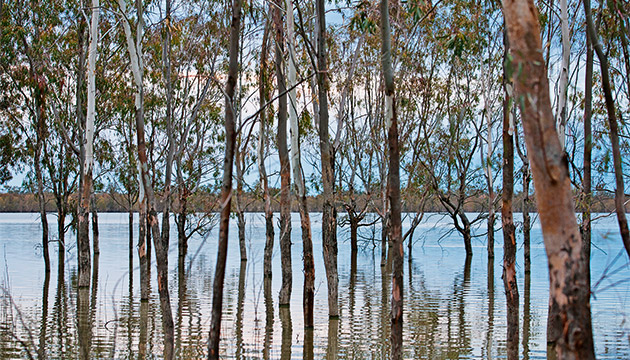A PROJECT THAT RE-CREATES THE MURRAY RIVER’S NATURAL FLOWS IS BREATHING NEW LIFE INTO THE NORTHERN MALLEE.
Story By Nathan Dyer
Leaning against the mottled trunk of a 500-year-old river red gum, Brendan Rodgers peers up at a thick bough covered in soft green shoots of foliage. Waddling along the branch towards a hollow are two galahs. Bright pink against the dark canopy, the pair of parrots is a handsome sight as they fidget about their nest, the waters of Lake Hattah gently lapping against the base of the tree. For Brendan, the nesting galahs and the red gum represent the life cycle of these lakes.
A project manager with Parks Victoria, Brendan speaks of the old gums with reverence. “The red gum is the key species in this floodplain; it provides so much life,” he says. “It all starts with the red gum and everything else works around it; they really are a giant of the floodplain.” Although the gum towering above Brendan is today shooting new growth and providing habitat for nesting birds, it is a starkly different story for many of the gums in the 48,000-hectare Hattah-Kulkyne National Park in Victoria’s semi-arid northern Mallee region, 70 kilometres south of Mildura.
Recognised under the Ramsar Convention as having international significance, the Lake Hattah system supports more than 200 bird species, including the nationally threatened regent parrot and endangered malleefowl. When full, the lakes are home to Murray cod, golden perch, redfin, yabbies and Murray crayfish. Kangaroos and emus are abundant across the park’s three key habitats of riparian river red gums, cypress pine and buloke sandy plains and black box woodlands.
But Brendan says with no major floods since 1996, many of the species supported by the inland lakes system were under stress – particularly the giant river red gums that surround all 21 of the system’s freshwater bodies, providing shade, shelter and soil stability. By the early 2000s, up to 80 percent of the gums were suffering. “We were seeing these trees die in front of our eyes,” Brendan says. “You start losing the key species and everything else starts to drop off.”
By 2004, the situation had become dire. “If we didn’t do something we were facing landscape-scale change, with the death of thousands of red gums,” Brendan says. The only option was to pump water up over the bank and into the system’s natural lifeline, the 20km Chalka Creek. With the support of a number of government and environmental agencies, between 2005 and 2010 about 50 gigalitres of irrigator-donated and allocated environmental water was pumped from the Murray River into the lakes system, reaching nine of the 21 lakes. Water birds returned in their thousands and there was significant red gum regrowth.
This story excerpt is from Issue #92
Outback Magazine: Dec/Jan 2014










